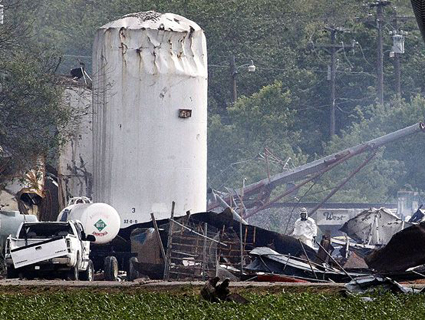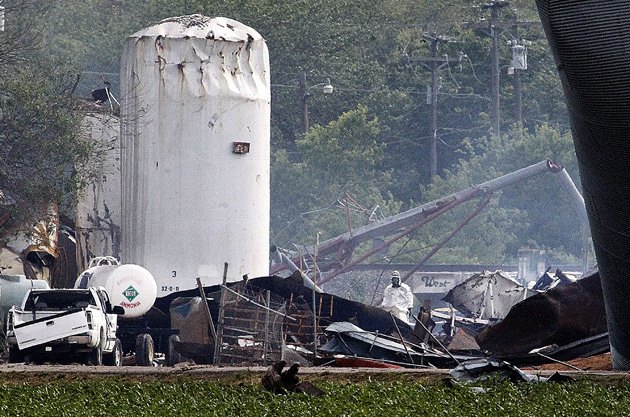
Searchers sift through the wreckate at the West Fertilizer Co. on April 18th. Ron Jenkins/MCT/Zuma
In the two and a half months since an explosion at a West, Texas, fertilizer storage facility left 12 first responders dead and at least 200 people injured, two things have become clear. The disaster could have been avoided if the proper regulations had been in place and enforced—and state and federal agencies don’t appear to be in a hurry to put those regulations in place or enforce them.
Texas, whose lax regulatory climate has come in for scrutiny in the aftermath of the West explosion, went into a special session of its state legislature on Monday to push through an omnibus abortion bill designed to regulate 37 abortion clinics out of existence. But the 2013 session will come to a close without any significant action to impose safeguards on the 74 facilities in the state that contain at least 10,000 pounds of ammonium nitrate.
Lawmakers in Austin have a handy excuse for punting on new fertilizer regulations: That would be intrusive. State Sen. Donna Campbell, the Republican who helped to shut down Democratic Sen. Wendy Davis’ filibuster of the abortion bill on procedural grounds, told the New York Times that lawmakers should be wary of monitoring chemical plants more closely because there’s “a point at which you can overregulate.”
As the investigations into the West blast have shown, though, over-regulation is hardly a risk in Texas. The disaster was notable for just how little regulation there actually was and how little it was enforced. Since the April 17 disaster we’ve learned that:
- The Texas Department of State Health Services, which tracks the storage of dangerous chemicals, says it is prohibited from regulating those chemicals and that any regulations must come from local officials. Except…
- West is in McLennan County, which, like 70 percent of counties in the state, had been statutorily prohibited from adopting its own fire code until 2010, when it reached a high-enough population threshold. It has not adopted one since.
- Texas is one of just four states without statewide standards for fire safety and storage at chemical facilities.
- Free from the constraints of fire codes, the West Fertilizer Co. stored ammonium nitrate in wooden boxes and didn’t even have a sprinkler system.
- A statewide cap on property taxes means that even if they were allowed to have fire codes, most rural Texas fire departments are unable to afford the equipment needed to fight fires at the chemical facilities that are located disproportionately in rural counties.
- The company didn’t notify local planners of the presence of dangerous chemicals on site until 2012—at least six years after federal law would have required them to do so—and the town’s volunteer firefighters were never briefed on how to handle a blaze at the facility. One firefighter tried to look up the information on his smartphone en route to the blaze but gave up.
- West Fertilizer Co.’s “worst-case release scenario,” according to documents provided to the Environmental Protection Agency, did not allow for the possibility of fire or explosions.
- The site hadn’t been inspected by the Occupational Safety and Health Administration since 1985, when, after finding five “serious violations,” the company was fined $30. (That’s $64.95 in today’s dollars.) The 28-year lag between inspections isn’t so bad, considering OSHA has the manpower to inspect each chemical facility in the US about once every 129 years.
- West Fertilizer Co. was insured for just $1 million, the same amount of liability coverage the state requires of bounce house operators. However, this was $1 million more than is required by the state for chemical storage facilities.
- The facility was storing an explosive product that doesn’t actually have to be explosive.
- It understated the amount of said explosive material it was keeping at the site by 56,000 pounds (or about 50 percent).
- The company did not work with the Department of Homeland Security to develop security procedures as required by federal law, nor did DHS ever instruct it to do so. It did provide information on the site’s explosive contents to the Texas Department of Health Services, but that agency did not pass that information along to DHS, nor was it required to.
- West Fertilizer Co. had no security guards, alarm system, or perimeter fencing despite the fact that it was a storage facility for the primary ingredient of improvised explosive devices, and had been robbed 11 times (presumably by meth manufacturers) in 12 years.
- In that same period, police responded to five different reports of ammonia leaks from the facility.
- In the 11 years since the US Chemical Safety Board recommended the EPA regulate ammonium nitrate, the source of the West fire, the agency has made no move to do so. It is not included on the agency’s list of hazardous chemicals, and by extension, it’s not included on Texas’ list either.
- The facility was less than 3,000 feet away from two schools and a dense residential area and there are no federal or state laws on the books that would have prevented it from getting closer.
In other words, there’s plenty of low-hanging fruit for Texas lawmakers to tackle to prevent future Wests. And yet, in the wake of the explosion, the state of Texas has taken exactly one concrete step to prevent future disasters from happening: It created a website that allows people to determine if there’s a chemical plant in their neighborhood. That’s information that should certainly be available to the public, but it shouldn’t be confused with a step that’s making those plants safer.
The Texas state fire marshal offered to issue voluntary best-practices recommendations for counties without fire codes, and to inspect chemical facilities—again, voluntarily—if the owners so wished, but the effect of that is hampered by the fact that rural counties, where most chemical facilities are located, are still prohibited under Texas law from enacting fire codes. A bill that would have ended that prohibition, which Gov. Rick Perry declined to throw his support behind, went nowhere this session. It is not being considered at the special session.
Legislators also talked about suggesting that facilities put up some signs to notify people about the presence of potentially hazardous chemicals nearby.
The only public statements on West from the state’s top lawmakers in the last month came when the Federal Emergency Management Agency turned down Texas’ request for $17 million in disaster assistance for the disaster it did nothing to prevent on the grounds that Texas has the money to pay for it. (And it does—Texas’ rainy day fund is set to hit $8 billion by 2015.)
Maybe if pro-choice activists really want to stop Texas from regulating clinics they should just start calling them “fertilizer plants.”












